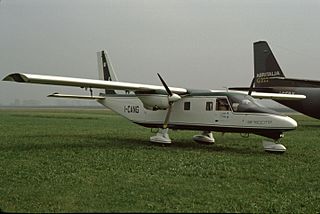The IAR-825 Triumf is a Romanian-designed tandem multirole trainer aircraft based on the IAR-823 built for the Romanian Air Force. The aircraft is roughly in the same class with the Brazilian EMBRAER Tucano. The IAR-825 is equipped with the Canadian Pratt & Whitney Canada PT6 turboprop engine. The type's first flight took place on the 12 June 1982.

The Cessna 340 is a twin piston engine pressurized business aircraft that was manufactured by Cessna.

The SZD-45 Ogar (Hound) is a T-tailed cantilever high-wing monoplane of wooden, aluminium and fibreglass construction designed and manufactured in Poland.

The PZL-Mielec M-20 Mewa is a licence-built version of the Piper PA-34 Seneca II manufactured in Poland by WSK PZL Mielec in a limited series from the 1980s.

The Grob G109 is a light aircraft developed by Grob Aircraft AG of Mindelheim Mattsies in Germany. It first flew in 1980. The G109B followed in 1984. It is a two-seat self-launching motor glider in which the pilot and passenger or student sit side by side, with good visibility provided by large windows.
The Valmet L-80 TP Turbo-Vinha was a prototype for a new Finnish turboprop basic trainer aircraft. The aircraft, which carried the registration OH-VBB, first flew on 12 February 1985. It was destroyed in a crash on 24 April 1985, during its 14th flight, killing the test pilot Paavo Janhunen. The aircraft was a further development of the Valmet L-70 Vinka and would eventually lead to the Valmet L-90 Redigo.

The Air Tractor AT-400 is a family of agricultural aircraft that first flew in the United States on September 1979. Type certification was awarded to Air Tractor in April 1980. Of low-wing monoplane taildragger configuration, they carry a chemical hopper between the engine firewall and the cockpit.

The Harbin SH-5 is a Chinese maritime patrol amphibious aircraft intended for a wide range of duties, including aerial firefighting, anti-submarine warfare (ASW) and air-sea rescue (ASR). One prototype and six production aircraft have been built.

The Piper PA-36 Pawnee Brave is a 1970s American single-engined, low-wing, propeller-driven agricultural plane built by Piper Aircraft.

The Fournier RF 5 is a two-seat motor glider designed by René Fournier.

The Vulcanair SF.600 Canguro was a feederliner developed in Italy in the late 1970s. Despite a number of attempts to put the aircraft into series production, only a small number were ever built. The Canguro was a high-wing cantilever monoplane of conventional configuration with a fuselage of rectangular cross-section and a high-set tail. The tricycle undercarriage was not retractable, and its main units were carried on sponsons on the fuselage sides. SIAI Marchetti provided funding towards the construction of the prototype, and constructed this aircraft at the former Aviamilano plant. After flight testing proved positive, the type was put on sale, but failed to attract buyers in any number, even when the original piston engines were exchanged for turboprops and retractable undercarriage was offered as an option.

The Hoffmann H40 was a prototype sport aircraft built in Germany in 1988. Designed by Wolf Hoffmann based on his Dimona motor-glider, it was a conventional, low-wing monoplane with side-by-side seating for two and tricycle undercarriage. The aircraft's high aspect ratio wings and T-tail were carried over from its motorglider heritage, but the span was shorter than that of the Dimona. Construction throughout was of composite materials. Hoffmann intended this aircraft to compete with sporting two-seaters such as the Grob G 115 and Robin ATL, but was unable to find the financial backing to bring the aircraft to market, despite a 30% share bought in the project by German pump manufacturer ABS.
The ICA IS-32 is an open class high-performance metal two-seat sailplane produced in Romania in the 1970s. A refinement of the IS-28B, it shared most of that aircraft's fuselage, mated to new wings and empennage. This new wing had a span of 20 metres, featuring interconnected ailerons and flaps, Schempp-Hirth-type airbrakes. It had no provision for water ballast. The monowheel undercarriage differed from the IS-28 in being fully retractable.

The Robin ATL is a French two-seat light aircraft designed by Avions Robin in the 1980s to meet a need for an economical two-seat aircraft to equip flying clubs. It is a single-engined monoplane with a fixed tricycle undercarriage, conventional control stick, and is, unusually, fitted with a V-tail. Due to the large bubble canopy, visibility is excellent. Its benign flight characteristics, moderate speeds and low fuel consumption, as well as some unique details, like an engine starter button which can only be pressed when the fuel selector switch is open, made the ATL a good trainer.

The Robin R 3000 is a French single-engined light aircraft designed and built by Avions Robin, which entered production in the 1980s.
The Fisher Culex and Culite are a family of American two-seat, twin-engined monoplanes. The aircraft is supplied in the form of blueprints for amateur construction, originally by Fisher Flying Products and now by Mike Fisher Aircraft.

The Akaflieg Berlin B13 is a two-seat motor-glider designed and built in Germany.
The Pottier P.220S Koala is a French two-seat light homebuilt aircraft and built by Avions Pottier. Further three and four seat variants were also developed.

The Ultimate Aircraft 10 Dash is a Canadian single-seat sport and aerobatic biplane designed and built by Ultimate Aircraft Corporation of Guelph, Ontario.
The Akaflieg Darmstadt D-39 was a single-seat motor glider derived from the D-38 sailplane. Built in Germany in the late 1970s, it was not intended for production and only one was constructed.















